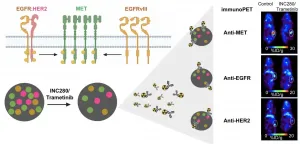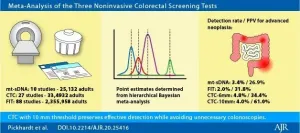Immuno-PET can give physicians early insight into tumor response to targeted therapy
2021-03-12
(Press-News.org) Reston, VA--Immuno-positron emission tomography (PET) imaging can provide early insight into a tumor's response to targeted therapy, allowing physicians to select the most effective treatment for patients who have cancer. The new research was published in the March issue of The Journal of Nuclear Medicine.
The research showed that immuno-PET successfully visualizes changes in different cancer receptors (receptor tyrosine kinases, or RTKs) within tumors during targeted therapies. This gives physicians a tool that can be used to evaluate the effectiveness of a treatment soon after its administration.
"When healthy cells turn into cancer cells, there is a disruption in the RTK signaling. This makes RTKs a valuable therapeutic and imaging target," said Patricia Pereira, Ph.D., a research associate at Memorial Sloan Kettering Cancer Center in New York, New York. "Techniques that allow for real-time monitoring of RTK dynamics, such as immuno-PET, could be very beneficial in informing treatment choice and predicting response."
Immuno-PET uses a "tracer" to follow an antibody directed to a specific tumor. This allows physicians to obtain images of events happening at the tumor site and provides information into whether the tumor responds to the treatment. The physician can then visualize how the tumor is responding.
In this study, researchers used immuno-PET and three different antibodies to visualize three RTKs (MET, EGFR, and HER2) in a kidney tumor. Their results confirmed that immuno-PET visualizes RTKs in ways that determine the level of protein within a tumor. After administering a treatment, immuno-PET can detect changes in RTK levels that indicate whether a tumor is responsive to that treatment.
"Precision medicine involves the identification of certain gene mutations and expressions, as well as other features, that contribute individual tumor signatures," noted Pereira. "Our study shows that immuno-PET is a powerful technique to document RTK changes and predict tumors' response to targeted therapies."
INFORMATION:
This study was made available online in July 2020 ahead of final publication in print in March 2021.
The authors of "Immuno-PET Detects Changes in Multi-RTK Tumor Cell Expression Levels in Response to Targeted Kinase Inhibition," include Patricia M.R. Pereira and Jalen Norfleet, Department of Radiology, Memorial Sloan Kettering Cancer Center, New York, New York; Jason S. Lewis, Department of Radiology, Memorial Sloan Kettering Cancer Center, New York, New York, and Molecular Pharmacology Program and Radiochemistry and Molecular Imaging Probes Core, Memorial Sloan Kettering Cancer Center, and Departments of Pharmacology and Radiology, Weill Cornell Medical College, New York, New York; and Freddy E. Escorcia, Molecular Imaging Program, Center for Cancer Research, National Cancer Institute, National Institutes of Health, Bethesda, Maryland.
Visit JNM's new website for the latest research, and follow our new Twitter and Facebook pages @JournalofNucMed.
Please visit the SNMMI Media Center for more information about molecular imaging and precision imaging. To schedule an interview with the researchers, please contact Rebecca Maxey at (703) 652-6772 or rmaxey@snmmi.org
About JNM and the Society of Nuclear Medicine and Molecular Imaging
The Journal of Nuclear Medicine (JNM) is the world's leading nuclear medicine, molecular imaging and theranostics journal, accessed more than 11 million times each year by practitioners around the globe, providing them with the information they need to advance this rapidly expanding field. Current and past issues of The Journal of Nuclear Medicine can be found online at http://jnm.snmjournals.org.
JNM is published by the Society of Nuclear Medicine and Molecular Imaging (SNMMI), an international scientific and medical organization dedicated to advancing nuclear medicine and molecular imaging--precision medicine that allows diagnosis and treatment to be tailored to individual patients in order to achieve the best possible outcomes. For more information, visit http://www.snmmi.org.
Funders: Onartuzumab was provided by Genentech. The Radiochemistry and Molecular Imaging Probe Core and the Antitumor Assessment Core were supported by NIH grant P30 CA08748. This study was supported in part by the Geoffrey Beene Cancer Research Center of MSKCC (Jason Lewis), NIH NCI grant R35 CA232130 (Jason Lewis), NIH NCI grant ZIA BC 011800 (Freddy Escorcia), Mr. William H. and Mrs. Alice Goodwin and the Commonwealth Foundation for Cancer Research, and the Center for Experimental Therapeutics of Memorial Sloan Kettering Cancer Center. Freddy Escorcia is supported by the American Board of Radiology Leonard B. Holman Research Pathway and the Clinical Investigator Development Program of NCI and NIH. Patricia Pereira is supported by the Tow Foundation Postdoctoral Fellowship from the MSKCC Center for Molecular Imaging and Nanotechnology and the Alan and Sandra Gerry Metastasis and Tumor Ecosystems Center of MSKCC. No other potential conflict of interest relevant to this article was reported.
[Attachments] See images for this press release:

ELSE PRESS RELEASES FROM THIS DATE:
2021-03-12
Leesburg, VA, March 12, 2021--According to an open-access article in ARRS' American Journal of Roentgenology (AJR), compared with multi-target stool-DNA (mt-sDNA) and fecal immunochemical test (FIT), CT colonography (CTC) with 10 mm threshold most effectively targets advanced neoplasia (AN)--preserving detection while decreasing unnecessary colonoscopies.
"CTC performed with a polyp size threshold for colonoscopy referral set at 10 mm represents the most effective and efficient non-invasive screening test for colorectal cancer (CRC) prevention and detection," clarified first author Perry J. Pickhardt from the department of radiology ...
2021-03-12
UNIVERSITY PARK, Pa. -- Did you ever wonder how social networking applications like Facebook and LinkedIn make recommendations on the people you should friend or pages you should follow?
Behind the scenes are machine learning models that classify nodes based on the data they contain about users -- for example, their level of education, location or political affiliation. The models then use these classifications to recommend people and pages to each user. But there is significant bias in the recommendations made by these models -- known as graph neural networks (GNNs) ...
2021-03-12
A new study by UC Davis MIND Institute researchers suggests that executive control differences in autism spectrum disorder (ASD) may be the result of a unique approach, rather than an impairment.
Executive control difficulties are common in individuals with autism and are associated with challenges completing tasks and managing time. The study, published in Biological Psychiatry: Cognitive Neuroscience and Neuroimaging, sought to tease out whether these difficulties represent a disruption in proactive executive control (engaged and maintained before a ...
2021-03-12
Quantum dots are manmade nanoparticles of semiconducting material comprising only a few thousand atoms. Because of the small number of atoms, a quantum dot's properties lie between those of single atoms or molecules and bulk material with a huge number of atoms. By changing the nanoparticles' size and shape, it is possible to fine-tune their electronic and optical properties - how electrons bond and move through the material, and how light is absorbed and emitted by it.
Thanks to increasingly refined control of the nanoparticles' size and shape, the number ...
2021-03-12
A machine learning algorithm that predicts suicide attempt recently underwent a prospective trial at the institution where it was developed, Vanderbilt University Medical Center.
Over the 11 consecutive months concluding in April 2020, predictions ran silently in the background as adult patients were seen at VUMC. The algorithm, dubbed the Vanderbilt Suicide Attempt and Ideation Likelihood (VSAIL) model, uses routine information from electronic health records (EHRs) to calculate 30-day risk of return visits for suicide attempt, and, by extension, suicidal ideation.
Suicide has been on the rise in the U.S. for a generation ...
2021-03-12
What The Study Did: Researchers investigated whether acute COVID-19 symptoms are associated with the probability of subsequent depressive symptoms.
Authors: Roy H. Perlis, M.D., M.Sc., of the Massachusetts General Hospital in Boston, is the corresponding author.
To access the embargoed study: Visit our For The Media website at this link https://media.jamanetwork.com/
(doi:10.1001/jamanetworkopen.2021.3223)
Editor's Note: Editor's Note: The article includes conflict of interest and funding/support disclosures. Please see the article for additional information, ...
2021-03-12
What The Study Did: National claims data were used to look at changes in well-child care visits with out-of-pocket costs before and after passage of the Affordable Care Act.
Authors: Paul R. Shafer, Ph.D., of Boston University, is the corresponding author.
To access the embargoed study: Visit our For The Media website at this link https://media.jamanetwork.com/
(doi:10.1001/jamanetworkopen.2021.1248)
Editor's Note: Editor's Note: The article includes conflicts of interest disclosures. Please see the article for additional information, including other authors, author contributions and affiliations, conflict of interest and financial disclosures, and funding ...
2021-03-12
What The Study Did: Researchers compared rates of psychotropic drug prescriptions during adolescence and young adulthood between individuals born preterm and at term.
Authors: Christine S. Bachmann, M.D., of the Norwegian University of Science and Technology in Trondheim, Norway, is the corresponding author.
To access the embargoed study: Visit our For The Media website at this link https://media.jamanetwork.com/
(doi:10.1001/jamanetworkopen.2021.1420)
Editor's Note: Editor's Note: The article includes funding/support disclosures. Please see the article for additional information, including other authors, ...
2021-03-12
(Philadelphia, PA) - About 6.2 million Americans suffer from heart failure, an incurable disease with a staggering mortality rate - some 40 percent of patients die within five years of diagnosis. Heart failure is one form of heart disease, for which new therapies are desperately needed.
Now, in new work, scientists at the Lewis Katz School of Medicine (LKSOM) at Temple University identify a path to a promising novel therapeutic strategy, taking aim at a molecule in the heart known as G protein-coupled receptor kinase 5 (GRK5). In a study published online in the journal Cardiovascular Research, the scientists show in mice that reducing GRK5 levels can significantly improve survival ...
2021-03-12
Scientists have long theorized that supermassive black holes can wander through space--but catching them in the act has proven difficult.
Now, researchers at the Center for Astrophysics | Harvard & Smithsonian have identified the clearest case to date of a supermassive black hole in motion. Their results are published today in the Astrophysical Journal.
"We don't expect the majority of supermassive black holes to be moving; they're usually content to just sit around," says Dominic Pesce, an astronomer at the Center for Astrophysics who led the study. "They're just so heavy that it's tough to get them going. Consider how much more ...
LAST 30 PRESS RELEASES:
[Press-News.org] Immuno-PET can give physicians early insight into tumor response to targeted therapy




